This is a low-cost screamer circuit to add to our range of
alarm modules. It has been designed to protect your valuables on a 24 hour
basis.
Build this LOW- Cost
SCREAMER SIREN
![]()
Even if you don't think you have valuables, it will provide security to give
you peace of mind.
Many people think their valuable coin and stamp collections are safe when they
are at home but this is one of the most vulnerable times. Itís the time when
cat burglars enter your home and search the rooms almost undetected.
I was watching one of those afternoon talk shows recently and the topic was
multi-million dollar fraud.
The person being interviewed was a cat burglar of more than 25 years
experience. He claimed to have taken more than $50 million worth of jewellery
and furs from some of the richest homes in America.
Working with a partner, they entered a property during the time when the
occupants and staff were having their evening meal.
It is during this time that everyone is located in the kitchen and
dining room areas, leaving the bedrooms free for plundering.
The burglar claimed he could enter, search and leave a property within 7
minutes and in the 25 years of their operation, they were never detected once.
I don't know how they were eventually caught (and served a 12 year
imprisonment) but the fact remains, a standard alarm system is totally useless. Even
those mansions with patrolling dogs and outside infrared security were
defeated.
The dogs were put down by poisoned bait and the perimeter alarms were "turned
down" (his words).
He said the biggest give-away with any alarm system was the sign on the
property claiming "protected by.... "
He would find out how the system worked from the
manufacturer and defeat it.
He had plenty of time to "research" a property as a job only took a few minutes
and the rewards would last a week or more of prolific spending.
The robber admitted on television that he only worked 3-4 months of the year
and sold the rings and stones in broken-down form to crooked jewellers.
It makes you wonder how safe your property really is.
With all the stories you hear involving robberies, the common thread in all
cases is the need for silence. Most robbers are not violent individuals and
prefer to work under a veil of silence. The only way to give your self
protection under these circumstances is to fit an alarm that is activated via
hidden switches.
He told us that jewellery was generally kept in the bedroom; in hat boxes and
in lower drawers. Once you are aware of the standard hiding places, it is best
to create your own strategy and make it more difficult to be "cleaned out."
The purpose of this alarm is two-fold. Even if you don't have any "estate
jewellery" or coin collection, an alarm will keep prying eyes and fingers away
from your belongings.
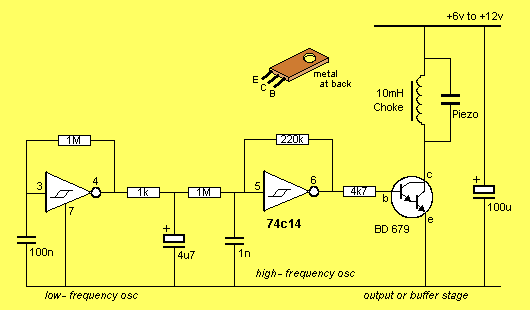
| The Screamer Siren Circuit |
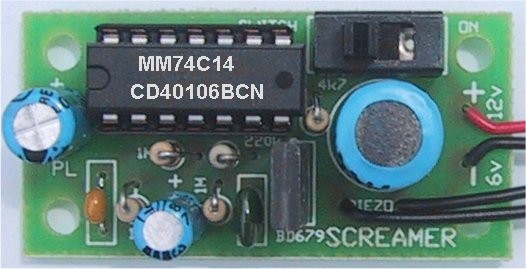
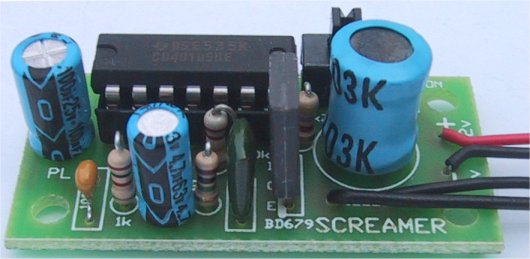
| Two views of the Screamer Siren |
HOW THE CIRCUIT WORKS
Voltage is applied to the chip via pins 14 and 7 so that when power is applied
to the project, the high and low frequency oscillators will come into
operation to produce a wailing sound from the piezo.
The high frequency oscillator is the only tone sent to the piezo. The low
frequency oscillator merely modifies the high frequency by putting a varying
"set on the 1n capacitor via the 1M so the frequency of the oscillator
changes. The low-frequency oscillator charges the 4u7 via the 1k and this
voltage is passed to the 1n via the 1M.
The best place to put the piezo is in the room you are protecting.
The result is an annoying wailing sound that is such a high frequency, and such
an amplitude, that it is difficult to determine where the sound is coming
from, especially when two or more piezo's are placed in the room. It would also
be difficult to remain in the room without becoming temporally deaf and
obviously not knowing if anyone has been alerted to the disturbance.
|
FEATURES:
|
OUTPUT STAGE
The output stage of the oscillator consists of a BD 679 Darlington transistor with a piezo tweeter and 10mH choke in the collector lead.
These two components form a resonant circuit at the frequency of operation and without the correct value of choke, the output would not be nearly as high.
The choke works by becoming a resistance path for the transistor when it is turned on and energy flows through the coil to create magnetic flux in the core. The transistor is driven by a square wave oscillator and it is switched off very fast by this type of waveform. The magnetic flux produced by the current flowing through the turns in the coil collapses very quickly when the current stops and produces a voltage across the coil that is of opposite polarity and very high in amplitude.
We have measured voltages of 70 - 120v and this voltage is passed to the piezo diaphragm to make it bend or "dish."
The piezo diaphragm behaves exactly like a 30n capacitor and the energy flows out of it after a short period of time to feed the choke.
The action of voltage flowing out of a capacitor is exactly the same as reversing the voltage direction and a short time later the transistor turns on again to start the cycle again.
The action of voltage flowing in and out of the piezo diaphragm causes the diaphragm to firstly dish in one direction and then the other direction. This movement creates sound waves that are reinforced (amplified) by the cone shape of the mouth of the piezo and this amplifies the characteristic harsh sound.
You cannot drive more than one piezo from the same driver transistor as the piezo and choke form a resonant circuit and you will upset the performance.
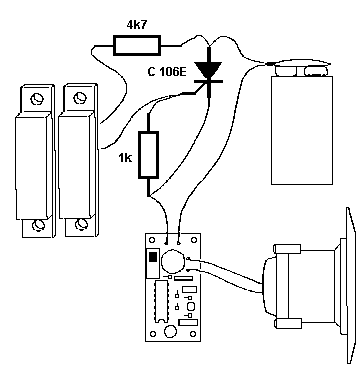
|
Simplest alarm system using the Screamer board and a thyristor to hold the siren ON |
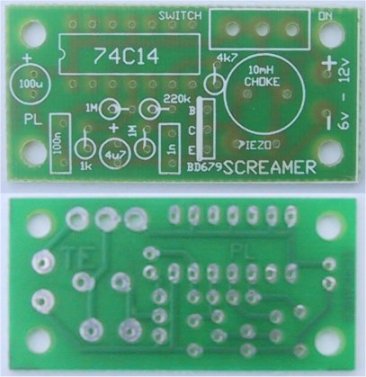
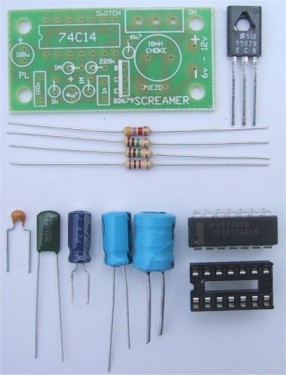
|
PARTS LIST |
|
1 - 1k 1 - 4k7 1 - 220k 2 - 1M 1 - 1n greencap 1 - 100n monoblock 1 - 4u7 electrolytic 16v PC mount 1 - 100u electrolytic 16v PC mount 1 - BD 679 Darlington transistor 1 - 74C14 Hex Schmitt trigger IC 1 - 14 pin IC socket 1 - 10mH choke 1 - SCREAMER SIREN PC board Extras: 1 - Piezo tweeter |
CONSTRUCTION
All the components fit on a small PC board and you must use modern, small-size parts so that they fit on the board. All the resistors are 1/4 watt and the electrolytics are 16v or 25v. Don't use old or large parts as they will not fit.
Keep everything close to the board to make the finished product look neat and solder the leads quickly so that the heat does not run up the leads and damage the component.
This applies especially to the 100n mono-block as the leads are soldered inside the capacitor to the ceramic substrate. This is very low-temperature solder and can easily be remelted to make the leads weak or even fall off.
You should also be careful with the transistor as excessive heat will change its characteristics, including its gain.
Always fit an IC socket to any project requiring a chip. This is standard practice with our kits as you may need to check the IC at some future date, if a fault occurs.
A cut-out at the end of the IC socket corresponds to the cut-out on the overlay and this helps you fit the chip around the correct way.
Leave the fitting of the chip to last but make sure the transistor is around the correct way as the thick line on the overlay identifies the metal side of the device. The resistors, 1n and 100n capacitors and choke can be fitted around either way as they are not polarity sensitive. The 4u7 and 100u electrolytics must be fitted so that the positive lead goes down the marked hole. You will find the negative lead is identified by a stripe down the side of the body of the electrolytic so that the other lead is positive.
SET UP
Place the alarm and piezo in the room you want protected and use either a
mercury switch or magnetic reed switch as the "trigger." Simply
tape the switch to a box or the back of a computer, along with the magnet
holding the switch OFF. If anyone disturbs the item, they will pull the switch
off and separate it from the magnet. This will turn on the alarm. Replacing the
magnet will not stop the siren.
Provided you have the battery, board and piezo hidden, it will not be easy to
turn the alarm off.
The incredibly loud noise will force the intruder to make his immediate escape
as he will not know if someone has been alerted to the disturbance and could be
trapped or apprehended.
This is the most successful alarm ever invented. Try it.